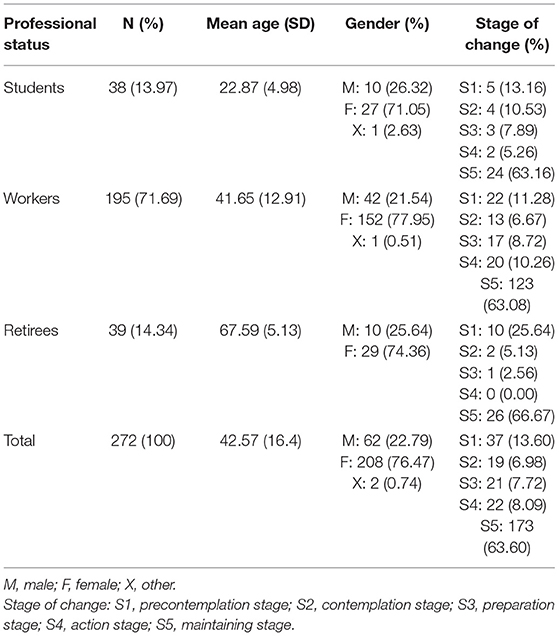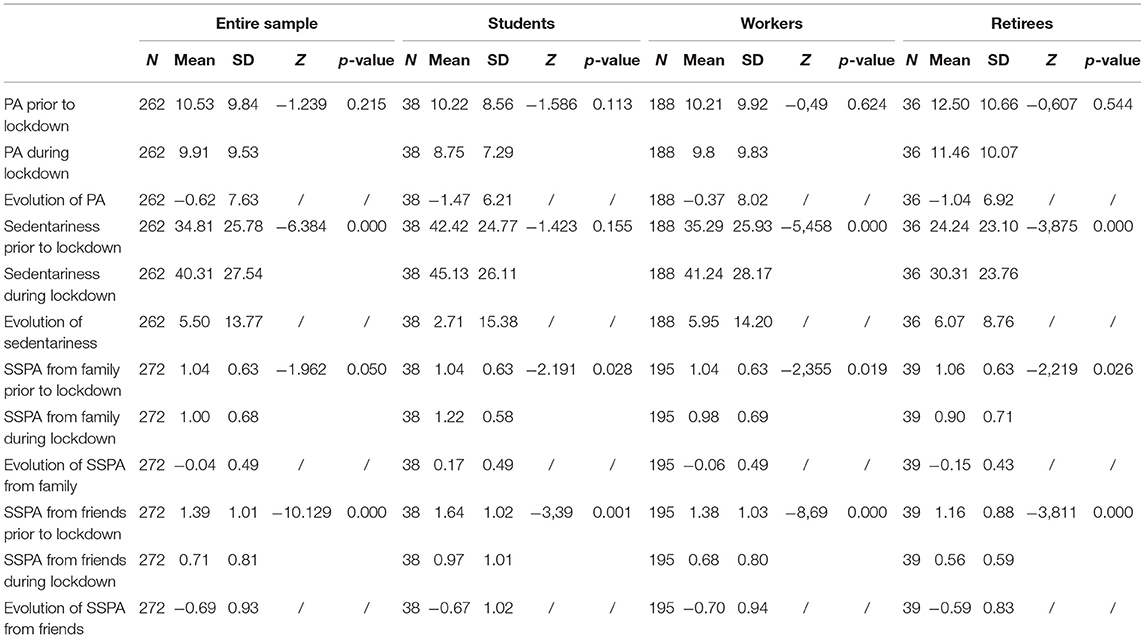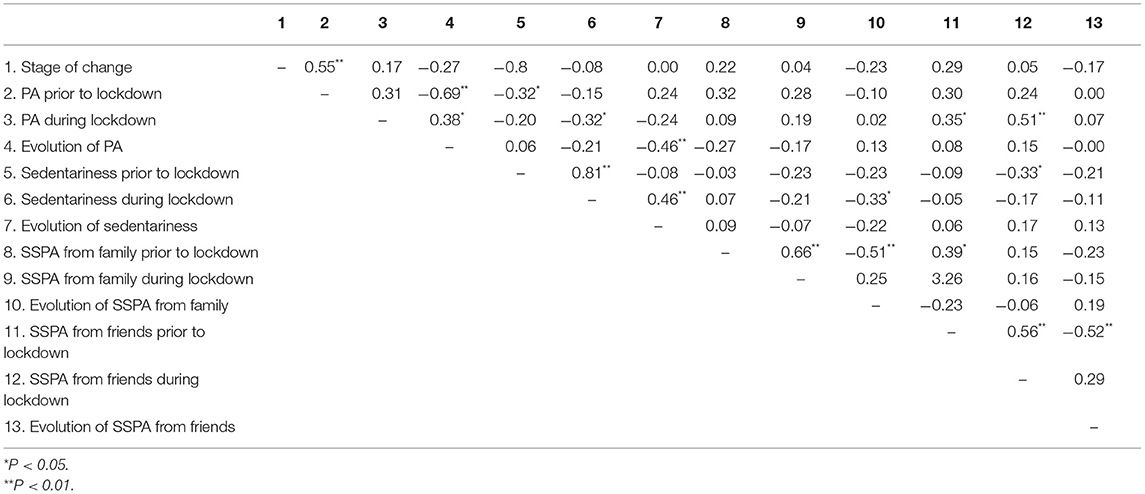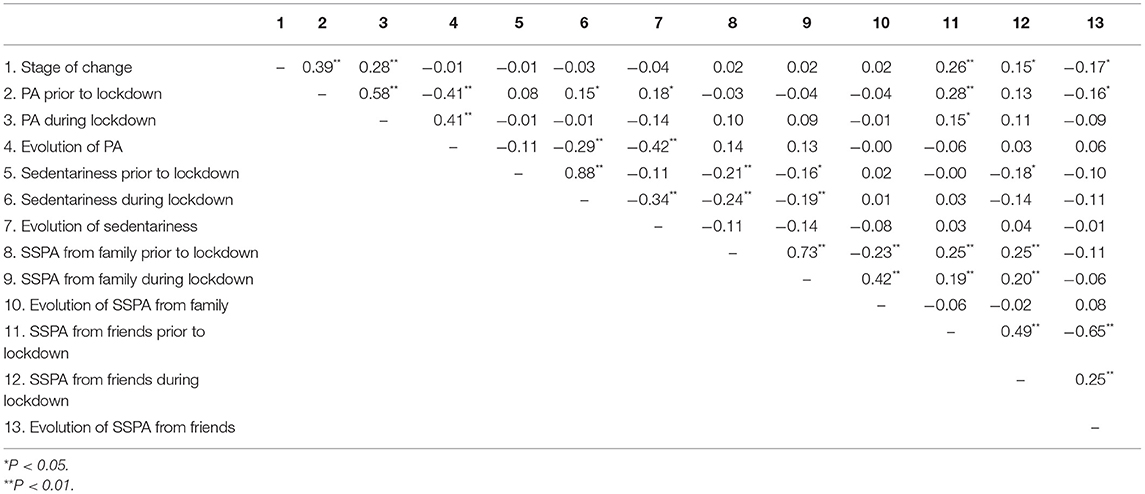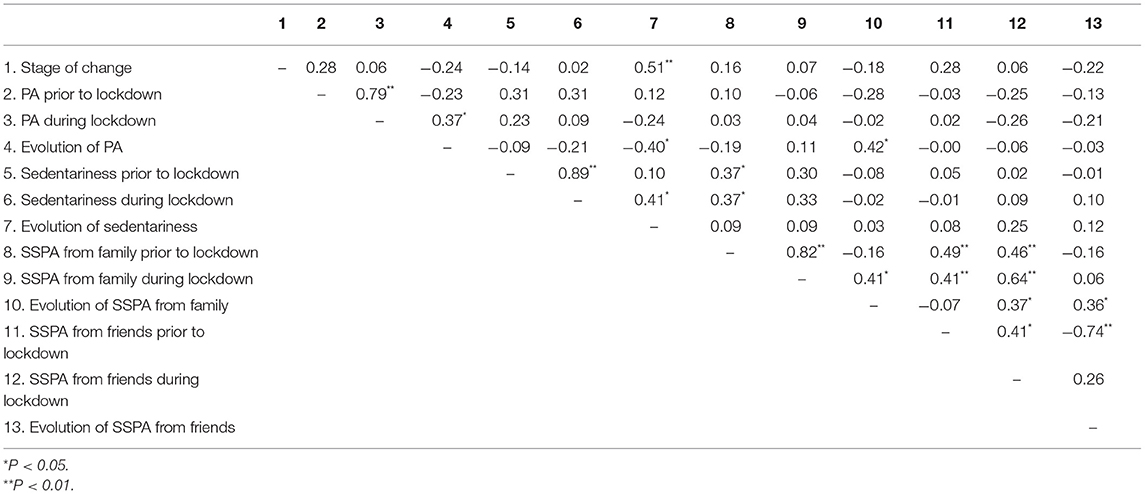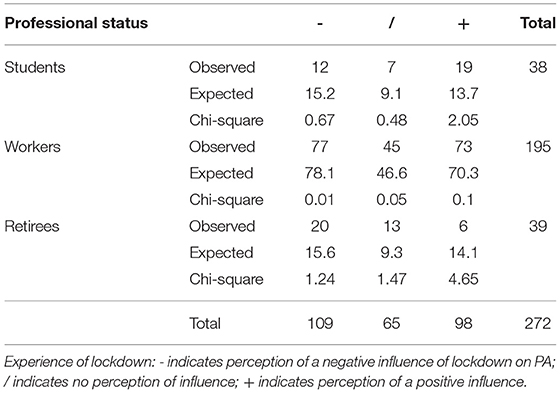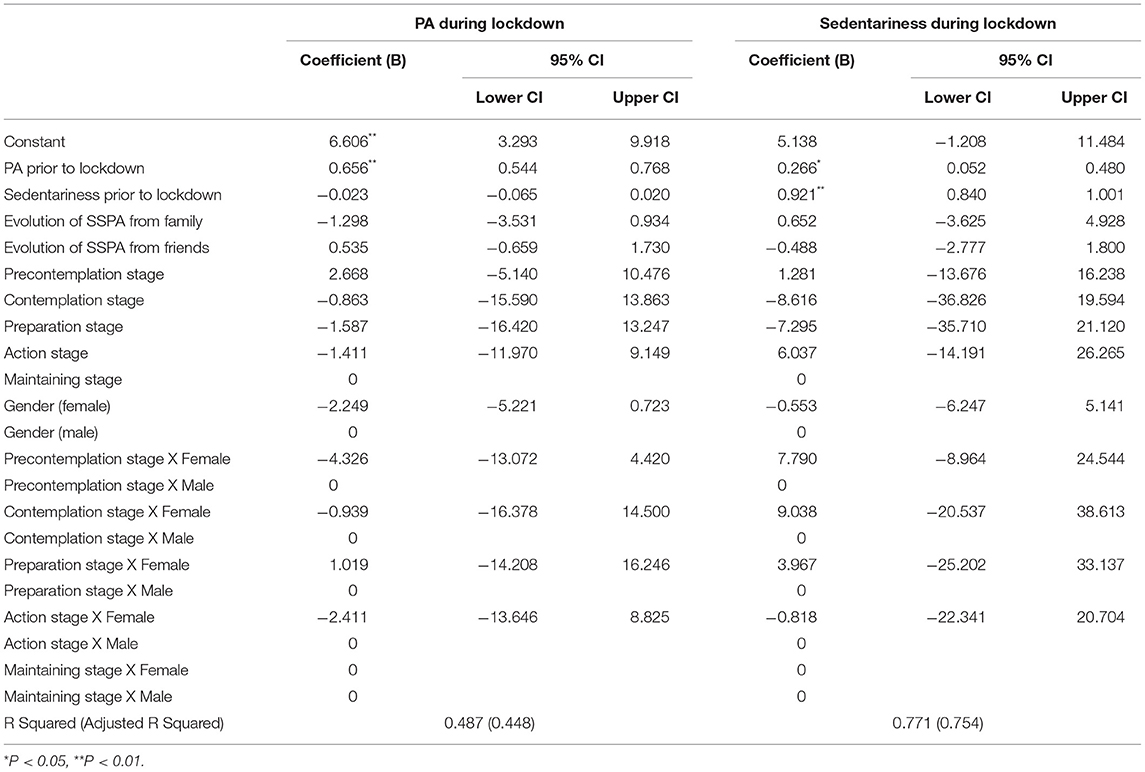The Influence of COVID-19 Lockdown on Physical Activity, Sedentary Behavior and Social Support Specific to Physical Activity Among Belgian Adults
- Faculty of Motor Sciences, Institute for the Analysis of Change in Contemporary and Historical Societies, Université Catholique de Louvain, Louvain-la-Neuve, Belgium
In Belgium, lockdown measures were taken to counter the spread of COVID-19. This major life-change event may disrupt a person's daily routine and influence health behaviors. Although measures were restrictive, citizens were encouraged to engage in physical activity (PA) behavior in order to maintain well-being. Social support specific to PA (SSPA) had been highlighted as an important psychosocial factor in initiating and/or maintaining active behavior. The main aims of this study were to explore the influence of COVID-19 lockdown on PA and sedentary behavior, and on SSPA from family and from friends; and investigate the potential differences in terms of professional status. An online survey was distributed during the 1st weeks of the lockdown. A total of 272 Belgian adults responded to the survey. The findings show no significant difference between prior to and during lockdown with regard to the amount of PA. The results show a significant increase in sedentary behavior among the entire sample, workers and retirees. The findings also suggest that the support of other individuals is particularly useful for certain population groups such as retirees. Given the importance of the levels of PA and sedentariness as health behaviors preceding a major life-change event such as a lockdown, there is a need to promote these health behaviors during normal life in order for the population to remain active throughout their lifespan.
Introduction
Life experiences that may greatly influence an individual's daily routine are referred to as life-change events (Holmes and Rahe, 1967) and have been defined as significant experiences involving a relatively abrupt change that may produce profound and long-lasting effects (Olafsson and Svensson, 1986; Settersten and Mayer, 1997). Stressful events may influence health behaviors either by disrupting an individual's ability to engage in such behaviors, or by increasing engagement in negative health-related behaviors. Life-change events may create emotional distress and disrupt a person's daily routine, thus affecting the commitment to be physically active (Engberg et al., 2012). A systematic review focused on the influence of life-change events on physical activity (PA) identified 5 life-event domains: changes in employment status, changes in residence, changes in physical status, changes in relationships, and changes in family structure (Allender et al., 2008). In a longitudinal study among young adults, Paluch et al. (2018) reported that life-change events can result in both positive and negative changes in PA behaviors.
On 11th March 2020, the World Health Organization declared the coronavirus disease 2019 (COVID-19) to be a global pandemic. In order to deal with the spread of COVID-19, many public health recommendations and regional and national government measures have resulted in numerous restrictions on daily living including social distancing, isolation and home lockdown. Worldwide, this COVID-19 lockdown had a negative effect on PA, and increased sedentary behavior (Ammar et al., 2020; Tison et al., 2020). Nevertheless, individuals were able to adapt quickly in the face of lockdown to improve their health behaviors, such as physical activity (López-Bueno et al., 2020). In Belgium, the government opted for the first lockdown measures starting on 13th March 2020, whereby schools were closed, homeworking became the new standard whenever possible, and social relations were greatly restricted. Based on these measures, lockdown can impact different areas of life by changing people's working conditions, their relationships, or their health status. However, although sports centers, gyms and other indoor sports facilities were closed, citizens were encouraged to engage in PA behavior in order to maintain well-being. More specifically, citizens were encouraged to engage in PA at home, or outdoors, alone, with members of the same household, or with a single friend.
Many behavior change theories (Bandura, 1986; Rosenstock et al., 1988), as well as health behavior adoption theories (Prochaska and DiClemente, 1983; Ajzen, 1991; Schwarzer, 2008) have highlighted the importance of psychosocial factors in the form of social support (SS) in initiating and/or maintaining active behavior. Social support was defined as any behavior that assists a person in achieving a desired goal (Taylor et al., 1994). This support for the individual can come from several sources within that individual's social network (e.g., family, friends, co-workers). The composition of this individual's social network seems to be influenced by life-change events, especially those related to education and employment. Indeed, starting higher education at college or University can be accompanied by significant changes in terms of residence, distance from family, and the creation of new social contacts. The world of work offers opportunities to create and maintain social networks. At the time of retirement, contact with colleagues may decrease, while this life-change event increases the time available to be with family, friends, or neighbors. In a cohort study focusing on the evolution of the social network during the transition to retirement, Kauppi et al. (2021) suggested that the reduction in social relationships is more likely to be associated with retirement than with the individual's own aging. The SS specific to PA (SSPA) can take several forms, such as emotional support, informational support, instrumental support, modeling, and co-participation (Duncan et al., 2005; Laird et al., 2016). There have been a number of systematic reviews of the literature on the influence of SSPA as a determinant of PA (Lindsay Smith et al., 2017; Scarapicchia et al., 2017; Van Luchene and Delens, 2021). With regard to college and University students (Van Luchene and Delens, 2021), there appears to be a positive association between SSPA from friends and family and PA. According to a systematic review of healthy adults (Scarapicchia et al., 2017), there is a small positive association between support for PA on the part of friends, and future PA. With regard to older adults, higher amounts of SSPA from all sources combined, and from family particularly, are associated with higher levels of PA, or meeting PA guidelines (Lindsay Smith et al., 2017).
As the entire population was affected by the lockdown at the same time and given the relational and professional drastic changes linked to COVID-19 lockdown, understanding the evolution of SSPA from friends and family during this unprecedented life-change event, and its potential link with changes in PA and sedentary behaviors is scientifically interesting in order to better understand reactions to life-change events with regard to PA practices. Therefore, the aims of this study were to: (1) explore the perception and influence of COVID-19 lockdown on PA and sedentary behaviors, and the potential differences in terms of professional status; (2) explore the influence of COVID-19 lockdown on SSPA from family and from friends, and the potential differences in terms of professional status; and (3) explore the potential links between changes in SSPA from family and from friends and changes in PA and sedentary behaviors, and the potential differences in terms of professional status.
Materials and Methods
Participants and Procedure
An online survey in French was disseminated from the authors' social networks and by a publication on the official site of the Catholic University of Louvain. Convenience sampling was used to select the participants of the study. For this study, only a part of the entire online survey was used. The survey was carried out between April 1st and April 22nd, 2020, corresponding to the first moments of lockdown in Belgium in order to best analyze the lockdown as a life-change event disrupting the daily life of individuals. Two inclusion criteria in terms of age and place during the COVID-19 lockdown were employed. With regard to age, participants had to be over the age of 18 in order to allow the authors to compare different professional statuses (students, workers, and retirees). With regard to place during the COVID-19 lockdown, because the lockdown measures applied were specific to each country, participation was limited to Belgian adults. The study sample consisted of 272 participants with a mean age 42.6 (SD = 16.4) years who completed the online survey concerning the following dimensions: demographic information, perceived influence of lockdown, physical activity, sedentary behavior, social support specific to physical activity from family and social support specific to physical activity from friends.
Measures
Demographic Information
Demographic questions consisted of 5 items. Items included age, gender, level of education, professional status, and parenthood status. Demographic information pertinent to this study were age, gender, and professional status.
Perceived Influence of Lockdown
The perceived influence of lockdown on the participants' PA was assessed using a single question “Specify the overall influence of COVID-19 lockdown on your physical activities practice.” Participants were asked to select one of three levels of perceived influence: incentive to engage in PA, no influence on PA, or barrier to engage in PA.
Physical Activity and Sedentary Behavior
The level of exercise prior to lockdown was assessed using the Stage of Change to Exercise Behavior Scale (SOC) proposed by Marcus et al. (1992). The SOC asks participants to select one of five ordered statements that best describes the level of exercise prior to lockdown: precontemplation, contemplation, preparation, action, and maintenance. A modified version of the International Physical Activity Questionnaire short form (IPAQ-SF) (Craig et al., 2003) was used twice to assess the participants' PA and sedentary behavior for 7 consecutive days in a typical week prior to lockdown, and during the last 7 days of lockdown. Participants were asked to recall the amount of time they spent doing moderate to vigorous, light, sitting and lying, or sleeping activities.
Social Support Specific to Physical Activity
The SSPA was measured using the Social Support for Exercise Scale (SSES) (Sallis et al., 1987). The SSES consists of a 15-item scale with regard to family support and 5-item scale with regard to friends support, that assesses the frequency of such support over the 3 months prior to lockdown and since the beginning of lockdown using a 5-point scale (1 = none to 5 = very often). The current study found the SSES scores to have a good internal consistency (SSPA from family prior to lockdown: α = 0.84; SSPA from family during lockdown: α = 0.86; SSPA from friends prior to lockdown: α = 0.80; SSPA from friends during lockdown: α = 0.83).
Calculated Data
The evolution of PA, sedentariness, SSPA from family, and SSPA from friends, between prior to and during lockdown, were computed by subtracting the values prior to lockdown from the values during lockdown (evolution = during lockdown—prior to lockdown). Positive data means an increase between prior to and during lockdown and negative data means a decrease.
Data Analyses
Data were imported into Statistical Package for Social Sciences software version 25 (IBM Corp, Armonk, NY, USA) in order for it to be analyzed. When outliers were found, they were recoded as missing values for the variable in question. Preliminary analyses were conducted which included checking for missing data, removing multivariate outliers, and running descriptive statistics such as means, standard deviations, reliabilities, and normality. Non-parametric statistics were conducted because normality was not respected in at least one of the professional status subgroups for each variable investigated. After descriptive analyses, correlation analyses were conducted to gain a preliminary insight regarding the relationships among the predictor and outcome variables. Then, the Wilcoxon test, the Kruskal-Wallis test, and the Mann-Whitney test were conducted to determine whether the means of the variables significantly differed between professional statuses. Finally, general linear models were carried out according to professional status. The alpha level of 0.05 was used for all statistical analyses.
Results
Descriptive Statistics, Evolutions in PA, Sedentary Behavior and SSPA Over Time, and Comparisons in Terms of Professional Status
A total of 272 participants (76.47% female) between 18 and 76 years of age filled out the online survey: 38 were college or university students (71.05% female; 63% in maintaining stage), 195 were workers (77.95% female; 63% in maintaining stage), and 39 were retirees (74.36% female; 67% in maintaining stage). Table 1 provides an overview of the participant characteristics.
Means and standard deviations for the variables of PA, sedentariness, SSPA from family and SSPA from friends are computed for the entire sample and by professional status (see Table 2). Statistical analyses show no significant difference between prior to and during lockdown with regard to the amount of PA among the entire sample, and in terms of professional status. There are significant increases in sedentariness among the entire sample (p = 0.000), workers (p = 0.000) and retirees (p = 0.000); a significant increase in SSPA from family among students (p = 0.028); significant decreases in SSPA from family among the entire sample (p = 0.050), workers (p = 0.019) and retirees (p = 0.026); and significant decreases in SSPA from friends among the entire sample (p = 0.000), students (p = 0.001), workers (p = 0.000) and retirees (p = 0.000). Figure 1 presents the differences in evolution over time, and comparisons between the professional statuses. The Kruskal-Wallis analyses show a significant difference concerning SSPA from family (p = 0.002). There are significant differences between students and workers (p = 0.008) and between students and retirees (p = 0.003).
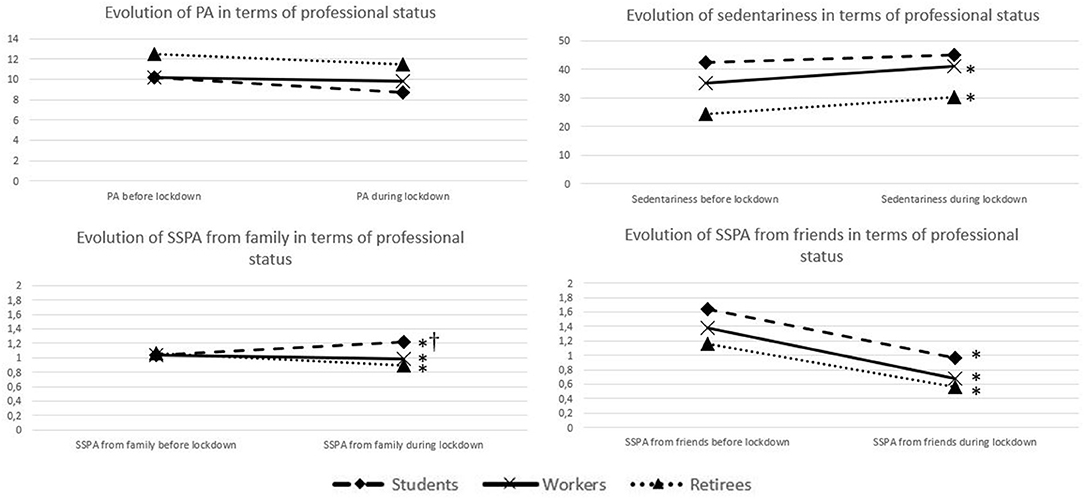
Figure 1. Evolutions over time and comparisons in terms of professional statuses of PA, sedentariness, SSPA from family and SSPA from friends. *indicates significant differences between prior to and during lockdown (P < 0.05). †indicates significant difference between the evolution of students and the evolution of workers and retirees (P < 0.05).
Bivariate Correlations
Bivariate correlations were examined for PA, sedentariness and SSPA variables according to professional statuses (see Tables 3–5). For each professional status, PA during lockdown is positively correlated with one or more PA' and SSPA from friends' variables, and negatively correlated with sedentariness during lockdown only on the part of students. Sedentariness during lockdown is positively correlated with sedentariness prior to lockdown for each professional status, negatively correlated with PA during lockdown for students, negatively correlated with one or more SSPA from family variables for students and workers, and positively correlated with SSPA from family prior to lockdown for retirees.
Perception of COVID-19 Lockdown on Physical Activity
In chi-square analyses, the frequencies of perception of the influence of lockdown are significantly different depending on professional status (χ2 = 10.69, p = 0.030). As shown in Table 6, the proportion of students and workers who perceived lockdown as having a positive effect on their PA practice is higher than expected, while the proportion in terms of retirees is lower.
General Linear Models
In the general linear models, PA and sedentariness during lockdown were predicted by PA and sedentariness prior to lockdown, the evolution of SSPA from family and from friends, the SOC, and gender, together explaining, respectively, 59 and 57% of variance with regard to students (see Table 7), 45 and 75% of variance with regard to workers (see Table 8), and 77 and 91% of variance with regard to retirees (see Table 9). Among students, PA prior to lockdown (F = 45.460, p = 0.000) and SOC (F = 3.980, p = 0.012) are significantly associated with PA during lockdown; sedentariness prior to lockdown (F = 28.371, p = 0.000) is significantly associated with sedentariness during lockdown. Among workers, PA prior to lockdown (F = 134.396, p = 0.000) is significantly associated with PA during lockdown; PA prior to lockdown (F = 6.030, p = 0.015) and sedentariness prior to lockdown (F = 506.542, p = 0.000) are significantly associated with sedentariness during lockdown. Among retirees, PA prior to lockdown (F = 87.205, p = 0.000), the evolution of SSPA from family (F = 12.862, p = 0.001) and the evolution of SSPA from friends (F = 4.540, p = 0.043) are significantly associated with PA during lockdown; sedentariness prior to lockdown (F = 264.333, p = 0.000), the evolution of SSPA from friends (F = 4.663, p = 0.040) and the SOC (F = 3.394, p = 0.033) are significantly associated with sedentariness during lockdown.
Discussion
In order to deal with the spread of COVID-19, the Belgian government opted for lockdown measures whereby schools were closed, homeworking became the new standard whenever possible, and social relations were greatly restricted. Sports centers, gyms and other indoor sports facilities were closed. Citizens were encouraged to engage in PA behaviors in order to maintain well-being during this major life-change event. More specifically, citizens were encouraged to engage in PA at home, or outdoors, alone, with members of the same household, or with a single friend. The results of the study highlight that the whole population did not share the same perception of the influence of COVID-19 lockdown on the practice of PA. Indeed, the findings suggest that workers, and especially students, are more likely to feel the influence of lockdown as positive in terms of their active behavior, unlike retirees who are more likely to feel it more negatively.
Beyond the perceptions of the influence of lockdown, it is interesting to examine the evolutions of PA and sedentary behaviors over time, between prior to and during lockdown, in order to better determine the impact of this event. The current study found no significant difference in the amount of PA, in terms of the total sample or by professional status. Although there was no significant difference in the amount of sedentariness on the part of students, the results of the study showed significant increases in sedentariness behavior among the total sample, workers and retirees. These findings corroborate those of Ammar et al. (2020) who reported a worldwide negative effect of COVID-19 lockdown on PA intensity levels, as well as an increase in time spent sitting per day. The results of the study by Tison et al. (2020) also showed a worldwide decrease in active behavior. Indeed, the authors reported a decrease in step counts in the period after COVID-19 was declared a global pandemic. However, the findings of the study partly differ from those of Constandt et al. (2020) who showed increased frequencies of both PA and sedentary behaviors among Belgian Flemish adults. In their study, the increase in the frequency of PA was particularly observed among people who were low in terms of being active prior to the lockdown. In our study, the sample of physically active people appears to be over-represented compared to the low active individuals, which may partially explain the difference in the evolution of PA behavior. A study carried out by López-Bueno et al. (2020) on Spanish adults provided an optimistic view of the influence of lockdown on health behaviors and the capacity of individuals to adapt to a life-change event. Indeed, although there was a decrease in the number of people reaching the PA recommendations during the 1st week of confinement, this quota increased progressively until it reached a higher level than before lockdown. However, it is also reported that screen time, which can be considered sedentary, increased during confinement and is maintained over time.
The findings of the study highlight the significant influence of past behaviors on current behaviors in the face of a life-change event that changed social relationships and opportunities. Indeed, the amount of PA practice and the amount of sedentary time prior to lockdown are, respectively, positively associated with the amounts of PA practice and sedentary times during lockdown. Moreover, these are the components that best predict active and sedentary behaviors, respectively, during this life-change event. These findings are consistent with the literature, which highlighted the importance of past behavior on current behavior. Indeed, studies showed that past PA behavior was a significant predictor of students' current practice when entering University life (Wing Kwan et al., 2009; Crozier et al., 2015). The literature and the results of this study support the importance of promoting health behaviors and countering sedentary behaviors during normal living, in order to maintain a healthy lifestyle in the face of a life-change event.
Although past behaviors seem to be the most important elements in the maintenance of health behaviors, some psychosocial determinants, such as SSPA, also appear to be important. Due to the measures related to the spread of COVID-19, restrictions on social contacts result in less SSPA from friends throughout the entire population. However, the findings of this study highlighted the associations between PA and SSPA from friends during lockdown on the part of students. This suggests that, as PA was allowed with one friend, students feel the need to take advantage of this opportunity to practice their PA with a friend. Another interesting finding is that the evolution of SSPA from family among students is significantly different from that among workers and retirees. The results of the study show an increase of SSPA from family among students, while they show a decrease among workers and retirees. The increase among students can be understood by the place of residence during their studies. Indeed, in Belgium, students generally live on University campuses. During the lockdown, most students returned to their families. Therefore, this potential source of support was much more available than in normal student life. The difference of evolutions of SSPA from family in terms of professional status might be a possible explanation for the difference of evolutions of sedentariness according to professional status. Indeed, the results of the study show no difference in the evolution of sedentariness among students while workers and retirees present a significant increase in sedentary behaviors. Furthermore, among retirees, SSPA from family and from friends participate in an understanding of PA practice during lockdown, and only SSPA from family participates in the outcomes with regard to sedentary behavior. These findings suggest that the support of individuals is particularly important among retirees. A previous systematic review of older adults highlighted that SSPA from family was an important factor with regard to being physically active (Lindsay Smith et al., 2017). Due to lockdown, the isolation of older people from their networks, and thus from their sources of SSPA, might therefore have a greater impact on this population group than on students or workers. In a critical commentaries issue related to COVID-19, Son et al. (2021) point out that older adults tend to be homebound, and needed alternative exercise and social opportunities to maintain their health during the COVID-19 lockdown. These authors suggested that leisure professionals can promote PA and social well-being in older people by increasing opportunities at home, including additional online leisure services, volunteering opportunities and social interactions.
Limitations and Strengths
This study presents certain limitations. Firstly, this study includes a selection bias. Indeed, the sample was at convenience and not representative of the general population. It involves a sample of 272 individuals, in which physically active people is over-represented. In addition, the numbers of individuals in the students and retirees' subgroups are very small, this makes it difficult to draw conclusions. Future research could consider a larger sample of the population, one that is representative of the population with regard to different professional status and PA levels of individuals. Secondly, the measures prior to and during lockdown were self-reported and carried out at the same and single time. Despite the desire to carry out the survey very quickly at the beginning of the COVID-19 lockdown, the distance from habits prior to lockdown may be a bias of recall in terms of measurement. Thirdly, this study presents a confounding bias. Indeed, some demographic variables that could influence the data could have been considered in the statistical analyses, such as gender. In future research, confounding variables should be an integral part of the statistical analyses. Fourthly, the objective of the study was to investigate the possible link between SSPA and the subjects' practice of PA during the COVID-19 lockdown in Belgium. However, the SSES (Sallis et al., 1987) only gives overall indices of SSPA from family and friends. Future research could investigate the different forms of SSPA (informational, emotional, instrumental, co-participation and modeling) through the use of specific questionnaires, in order to observe the changes in forms of SSPA caused by a major life-change event. In addition, qualitative research could be of interest to gain a more in-depth understanding of the changes in health behaviors during such as drastic event.
Despite the above limitations, this study contains some strengths. The primary strength is that the authors do not only seek to observe activity and sedentary behaviors during lockdown, but also to observe changes compared to normal life. This was possible thanks to the quick diffusion of the survey at the beginning of the lockdown. Indeed, the intention was to observe the “acute” effect of this life-change event disrupting usual life. Moreover, the quick diffusion made it easier for participants to recall their pre-lockdown habits. The second strength of this study is that it seeks to understand these changes by relating the behaviors to some psychosocial elements such as SSPA. Finally, given the differences in social relationships and behaviors during normal life between groups of individuals, this study seeks to differentiate such groups in order to better understand the specific needs of each and best tailor subsequent recommendations.
Conclusions
Promoting active behaviors is important in order to maintain physical and psychological well-being during a major life-change event such as a lockdown. However, recommendations should also address the need to counter sedentary behaviors that cause many health issues. Indeed, although physical activity has not changed significantly, this study shows an increase in sedentary behaviors on the part of all adults, with the exception of students, taken separately. To this end, promoting multi-person or group activities is a relevant means of increasing and maintaining active behaviors, and limiting sedentary behaviors. Indeed, the findings suggest that the support of other individuals could be useful for certain population groups such as retirees. Furthermore, given the importance of the levels of health behaviors preceding a major life-change event such as a lockdown, there is a need to also promote these health behaviors during normal life in order for the population to remain active throughout their lifespan.
Data Availability Statement
The raw data supporting the conclusions of this article will be made available by the authors, without undue reservation.
Ethics Statement
Ethical review and approval was not required for the study on human participants in accordance with the local legislation and institutional requirements. Written informed consent for participation was not required for this study in accordance with the national legislation and the institutional requirements.
Author Contributions
CD, FD, and PV conceived the study. All authors were involved in analyzing of data, interpreting of results and revising the manuscript, and approve the final version of the paper.
Conflict of Interest
The authors declare that the research was conducted in the absence of any commercial or financial relationships that could be construed as a potential conflict of interest.
Publisher's Note
All claims expressed in this article are solely those of the authors and do not necessarily represent those of their affiliated organizations, or those of the publisher, the editors and the reviewers. Any product that may be evaluated in this article, or claim that may be made by its manufacturer, is not guaranteed or endorsed by the publisher.
Acknowledgments
The authors would like to thank the Catholic University of Louvain for the publication on the official site which facilitated the data collection; Céline Bugli, consultant of the Plateforme Technologique de Support en Méthodologie et Calcul Statistique (Catholic University of Louvain), and Arthur Lefebvre (Catholic University of Louvain, Louvain Research Institute in Management and Organizations) for the statistical advice.
References
Ajzen, I. (1991). The theory of planned behavior. Organ. Behav. Hum. Decis. Process. 50, 179–211. doi: 10.1016/0749-5978(91)90020-T
Allender, S., Hutchinson, L., and Foster, C. (2008). Life-change events and participation in physical activity: a systematic review. Health Promot. Int. 23, 160–172. doi: 10.1093/heapro/dan012
Ammar, A., Brach, M., Trabelsi, K., Chtourou, H., Boukhris, O., Masmoudi, L., et al. (2020). Effects of COVID-19 home confinement on eating behaviour and physical activity: results of the ECLB-COVID19 international online survey. Nutrients 12:61583. doi: 10.3390/nu12061583
Bandura, A. (1986). Social Foundations of Thought and Action: A Social Cognitive Theory. Social Foundations of Thought and Action: A Social Cognitive Theory. Englewood Cliffs, NJ: Prentice-Hall.
Constandt, B., Thibaut, E, De Bosscher, V., Scheerder, J., Ricour, M., and Willem, A. (2020). Exercising in times of lockdown: an analysis of the impact of COVID-19 on levels and patterns of exercise among adults in Belgium. Int. J. Environ. Res. Public Health 17:4426. doi: 10.3390/ijerph1711414426
Craig, C. L., Marshall, A. L., SjÖStrÖ, M. M., Bauman, A. E., Booth, M. L., Ainsworth, B. E., et al. (2003). International physical activity questionnaire: 12-country reliability and validity. Med. Sci. Sports Exerc 35:8. doi: 10.1249/01.MSS.0000078924.61453.FB
Crozier, A. J., Gierc, M. S. H., Locke, S. R., and Brawley, L. R. (2015). Physical activity in the transition to university: the role of past behavior and concurrent self-regulatory efficacy. J. Am. College Health 63, 380–387. doi: 10.1080/07448481.2015.1042880
Duncan, S. C., Duncan, T. E., and Strycker, L. A. (2005). Sources and types of social support in youth physical activity. Health Psychol. 24, 3–10. doi: 10.1037/0278-6133.24.1.3
Engberg, E., Alen, M., Kukkonen-Harjula, K., Peltonen, J. E., Tikkanen, H. O., and Pekkarinen, H. (2012). Life events and change in leisure time physical activity. Sports Med. 42, 433–447. doi: 10.2165/11597610-000000000-00000
Holmes, T. H., and Rahe, R. H. (1967). The social readjustment rating scale. J. Psychosom. Res. 11, 213–218. doi: 10.1016/0022-3999(67)90010-4
Kauppi, M., Virtanen, M., Pentti, J., Aalto, V., Kivimäki, M., Vahtera, J., et al. (2021). Social network ties before and after retirement: a cohort study. Eur. J. Ageing. doi: 10.1007/s10433-021-00604-y
Laird, Y., Fawkner, S., Kelly, P., McNamee, L., and Niven, A. (2016). The role of social support on physical activity behaviour in adolescent girls: a systematic review and meta-analysis. Int. J. Behav. Nutr. Phys. Activity 13, 1–14. doi: 10.1186/s12966-016-0405-7
Lindsay Smith, G., Banting, L., Eime, R., O'Sullivan, G., and van Uffelen, J. G. Z. (2017). The association between social support and physical activity in older adults: a systematic review. Int. J. Behav. Nutr. Phys. Activity 14:56. doi: 10.1186/s12966-017-0509-8
López-Bueno, R., Calatayud, J., Casaña, J., Casajús, J. A., Smith, L., Tully, M. A., et al. (2020). COVID-19 confinement and health risk behaviors in Spain. Front. Psychol. 11:1426. doi: 10.3389/fpsyg.2020.01426
Marcus, B., Banspach, S., Lefebvre, R. C., Rossi, J., Carleton, R. A., and Abrams, D. (1992). Using the stages of change model to increase the adoption of physical activity among community participants. Am. J. Health Promotion 6, 424–429. doi: 10.4278/0890-1171-6.6.424
Olafsson, O., and Svensson, P.-G. (1986). Unemployment-related lifestyle changes and health disturbances in adolescents and children in the western countries. Soc. Sci. Med. 22, 1105–1113. doi: 10.1016/0277-9536(86)90177-2
Paluch, A. E., Shook, R. P., Hand, G. A., O'Connor, D. P., Wilcox, S., Drenowatz, C., et al. (2018). The influence of life events and psychological stress on objectively measured physical activity: a 12-month longitudinal study. J. Phys. Activity Health 15, 374–382. doi: 10.1123/jpah.2017-030410.1123/jpah.2017-0304
Prochaska, J. O., and DiClemente, C. C. (1983). Stages and processes of self-change of smoking: Toward an integrative model of change. J. Consult. Clin. Psychol. 51, 390–395. doi: 10.1037/0022-006X.51.3.390
Rosenstock, I. M., Strecher, V. J., and Becker, M. H. (1988). Social learning theory and the health belief model. Health Educ. Q. 15, 175–183. doi: 10.1177/109019818801500203
Sallis, J. F., Grossman, R. M., Pinski, R. B., Patterson, T. L., and Nader, P. R. (1987). The development of scales to measure social support for diet and exercise behaviors. Prevent. Med. 16, 825–836. doi: 10.1016/0091-7435(87)90022-3
Scarapicchia, T. M. F., Amireault, S., Faulkner, G., and Sabiston, C. M. (2017). Social support and physical activity participation among healthy adults: a systematic review of prospective studies. Int. Rev. Sport Exerc. Psychol. 10, 50–83. doi: 10.1080/1750984X.2016.1183222
Schwarzer, R. (2008). Modeling health behavior change: how to predict and modify the adoption and maintenance of health behaviors. Appl. Psychol. 57, 1–29. doi: 10.1111/j.1464-0597.2007.00325.x
Settersten, R. A., and Mayer, K. U. (1997). The measurement of age, age structuring, and the life course. Annu. Rev. Sociol. 23, 233–261. doi: 10.1146/annurev.soc.23.1.233
Son, J. S., Nimrod, G., West, S. T., Janke, M. C., Liechty, T., and Naar, J. J. (2021). Promoting older adults' physical activity and social well-being during COVID-19. Leisure Sci. 43, 287–294. doi: 10.1080/01490400.2020.1774015
Taylor, W., Baranowski, T. F., and Sallis, J. (1994). “Family determinants of childhood physical activity: A social-cognitive model,” in Advances in Exercise Adherence, ed R. K. Dishman (Champaign, IL: Human Kinetics Publishers).
Tison, G. H., Avram, R., Kuhar, P., Abreau, S., Marcus, G. M., Pletcher, M. J., et al. (2020). Worldwide effect of COVID-19 on physical activity: a descriptive study. Ann. Intern. Med. 173, 767–770. doi: 10.7326/M20-2665
Van Luchene, P., and Delens, C. (2021). The influence of social support specific to physical activity on physical activity among college and university students: a systematic review. J. Phys. Activity Health 7, 685–694. doi: 10.1123/jpah.2020-0713
Keywords: active behavior, sedentary behavior, psychosocial determinants, COVID-19, life-change event
Citation: Van Luchene P, Detemmerman F and Delens C (2021) The Influence of COVID-19 Lockdown on Physical Activity, Sedentary Behavior and Social Support Specific to Physical Activity Among Belgian Adults. Front. Sports Act. Living 3:716386. doi: 10.3389/fspor.2021.716386
Received: 28 May 2021; Accepted: 25 August 2021;
Published: 20 September 2021.
Edited by:
Guillermo Felipe López Sánchez, Anglia Ruskin University, United KingdomReviewed by:
Deborah Riebe, University of Rhode Island, United StatesRubén López-Bueno, National Research Centre for the Working Environment, Denmark
Copyright © 2021 Van Luchene, Detemmerman and Delens. This is an open-access article distributed under the terms of the Creative Commons Attribution License (CC BY). The use, distribution or reproduction in other forums is permitted, provided the original author(s) and the copyright owner(s) are credited and that the original publication in this journal is cited, in accordance with accepted academic practice. No use, distribution or reproduction is permitted which does not comply with these terms.
*Correspondence: Pierre Van Luchene, pierre.vanluchene@uclouvain.be
 Pierre Van Luchene
Pierre Van Luchene Fanny Detemmerman
Fanny Detemmerman Cécile Delens
Cécile Delens